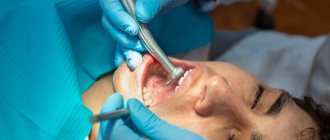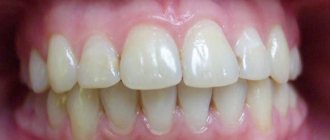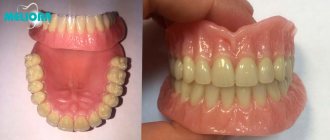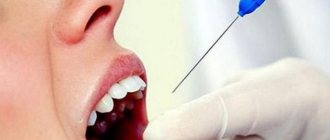Pain during treatment in the dental chair was considered normal for many years. Because of this, patients developed fear. As a result, many people put off visiting the doctor, causing irreparable damage to their teeth. Both patients and doctors are interested in painless treatment.
Anesthesia can completely eliminate unpleasant sensations, but in a clinic setting this method cannot always be implemented. The safest and most common solution if treatment is required to remove teeth without pain is to use local anesthesia. Medicines for it are constantly being improved, allowing the doctor to choose the optimal medicine in each individual case.
Modern dental treatment
Dental treatment of teeth is a set of measures aimed at eliminating the inflammatory process and restoring chewing functions. The most common disease is, of course, caries and its complications. The timing of dental treatment directly depends on the stage of development of the disease. Thus, installing a dental crown or implanting several teeth will take different times, depending on the number of specialist appointments. It is worth noting that regular preventive examinations allow you to notice pathologies at an early stage, allowing for dental treatment without extraction and significantly simplifying it.
If a patient comes to the clinic with acute pain, the task becomes much more complicated. Therefore, every dentist will tell you that the best dental treatment is prevention.
Photos before and after dental treatment
Photos Before and After treatment of chewing teeth.
Photos Before and After treatment of front teeth.
Why is it better to treat caries at the Medikastom dental clinic?
- Many years of experience. The dental clinic has been operating since 2000, successfully providing care to patients even with complex illnesses.
- Highly qualified staff who treat each patient with care and sensitivity.
- First-class equipment and modern drugs.
- Using the latest developments and treatment methods.
- Affordable cost of caries treatment.
- Maximum comfortable conditions for the patient.
- Caries treatment 24/7. Our clinic works for you around the clock, without holidays and weekends, providing qualified assistance when it is most needed.
You can get detailed information on caries treatment by calling us at +7(499) 283-71-58.
Call and sign up for a free consultation right now!
We are waiting for you!
Endodontic dental treatment
What is endodontic dental treatment? This is a procedure aimed at treating root canals, usually using a microscope. If you ignore the symptoms of caries for a long time, pulpitis, periodontitis and other complications develop. Endodontic treatment of teeth under a microscope will help eliminate acute pain and relieve inflammation. The help of an endodontist is indispensable when there is a suspicion of a dental cyst or granuloma. Often, after canal treatment, complications arise due to poor quality treatment or stuck pieces of broken instruments. In such difficult cases, they also resort to endodontic treatment of the tooth canal under a microscope.
Gum inflammation
Common gum diseases are gingivitis and periodontitis. In the first case, inflammation develops only in soft tissues and does not affect the dental unit. Characterized by swelling, redness and bleeding of the gums. If you do not seek dental care, gingivitis can become chronic. Or develop into periodontitis. This involves the root canals and hard tissues of the tooth. The adjacent gum peels off, and a purulent process begins in the resulting cavity. Without timely treatment of teeth, this leads to their loosening and loss.
The choice of therapeutic methods is based on the condition of the oral cavity and the severity of the pathology. As a rule, the following are used for the prevention and treatment of gum inflammation:
- Rinse procedures. After the examination, the doctor prescribes the optimal type of solution (alcohol-based antiseptics or with the addition of chlorhexidine).
- Ointments and gels (healing, anti-inflammatory, antifungal).
- Therapeutic toothpastes (anticaries, antiseptic).
- Medicines.
In most cases, soft tissue inflammation is caused by a poorly installed (polished) filling or crown. Therefore, when a disease appears, it is important not to delay visiting a doctor.
Physiotherapy (electrophoresis, darsonval, massage) is used as additional methods for treating soft tissue diseases in the oral cavity.
Treatment without drilling
Dental treatment without drilling involves the use of minimally invasive procedures. Some of them have been mentioned above. In particular, lasers are actively used to eliminate caries. This type of dental treatment is performed for adults and children. Among the main advantages is a reduced risk of any infection, since contact of equipment with organs and tissues of the oral cavity is eliminated.
Also, dental treatment without a drill can be performed using the chemical-mechanical method. A special preparation is applied to the area of the tooth affected by caries. It contains sodium hypochlorite and amino acids. Next, the specialist treats the affected area using special tools. Since only dead tissue is removed, the filling occupies a much smaller area, and it is also possible to preserve healthy areas as much as possible.
Another interesting technique was developed by German specialists. It is based on the bactericidal properties of ozone and is often used in pediatric dentistry. The gas used to treat teeth completely destroys microorganisms that cause caries.
The latest non-invasive methods
Before dental treatment, a specialist determines the degree of destruction of enamel, hard tooth tissue and dentin. In advanced cases, a granuloma forms around the root, which may subsequently increase in size. Modern methods of dental treatment make it possible to successfully combat the first signs of caries without the use of a drill. Among them:
- laser dental treatment;
- application of chemical-mechanical techniques;
- fluoridation – treatment of teeth with calcium;
- application of the air-kinetic method;
- ozone therapy.
Is it possible to treat teeth without a drill?
Sociological surveys show: almost 80% of people are afraid to visit the dentist due to fear of having their teeth drilled. Not only children, but also adults are afraid of drills. If you are also afraid of the need to drill a tooth for its quality treatment, then it will be useful for you to know the following fact: if you seek dental care in a timely manner during dental treatment, you can completely do without a drill!
Fluoridation
If the examination reveals caries in the stain stage, then dental treatment may involve procedures aimed at remineralizing and strengthening the enamel. Tooth surfaces are covered with special gels containing high concentrations of fluoride and calcium and, of course, this treatment is absolutely painless!
Laser treatment
Another option for dental treatment without drilling is the use of laser radiation with a wavelength of a certain length. The laser beam heats and destroys tissues destroyed by caries, and after treatment it will be enough to rinse the area of manipulation with water. The innovative method of dental treatment has many advantages, including: high efficiency of the method; low risks of complications; additional antibacterial effect. The disadvantages include the fairly high price of laser dental treatment and a wide range of contraindications. It is also worth knowing that dental treatment with laser radiation will be painless only when caries has destroyed only the tooth enamel. If the destruction has reached the deep layers of dentin and pulp, before laser dental treatment, the patient is given anesthesia to eliminate unpleasant painful sensations.
Infiltration treatment method
Dental treatment is carried out using Icon technology, which consists of treating carious cavities with a special polymer composition. The active substances in the composition uncouple and dissolve damaged tissue, the remains of which the doctor removes with an alcohol solution. Then the treated areas of the tooth are dried and treated with a polymer resin that fills micropores in the natural enamel coating of the tooth. The tooth treatment using Icon technology ends with the use of a polymerization lamp, which dries the applied composition. The advantages of this dental technique include: maintaining the integrity of the natural enamel coating for a long time, increasing the strength of tooth enamel; the ability to choose a polymer shade that exactly matches the tone of natural enamel; speed of dental treatment - the entire treatment process takes no more than half an hour; The treatment is painless and does not involve the risk of overheating of the tooth tissue.
Icon dental treatment technology is optimal for treating carious stains in the interdental spaces and is suitable for eliminating caries in children.
Ozone therapy
Another method of treating teeth without drilling is ozone therapy, which involves exposing carious cavities to ozone. The impact is carried out by a special device that converts oxygen into ozone. This gas destroys pathogenic microflora and carious bacteria. After treatment with ozone, the tooth is covered with a special gel and the treatment process ends.
Ozone therapy can be used not only to treat teeth damaged by caries. It is indicated for inflammation of the soft tissues of the oral cavity, inflammatory processes in the dental canals.
Treatment of a tooth under a crown
After some time has passed after the installation of the prosthesis, subsidence of the gums and exposure of the neck of the tooth are often observed. All this contributes to the development of caries, and therefore pulpitis, periodontitis and other unpleasant diseases can appear even when the tooth is covered with a crown. Only a specialist can identify the problem and treat the tooth under the crown. If a disease is detected, the structure may need to be removed.
It is also the cause of problems - errors in the manufacture of the prosthesis: if the crown does not fit tightly around the neck of the tooth, bacteria can get under it. The specialist immediately removes such structures and carries out dental treatment. The crowns will subsequently be replaced, which will preserve the teeth and prevent the development of more serious diseases.
The structure of the human tooth
Each tooth consists of a crown - a part of the tooth protruding above the surface of the gum, a root immersed in the bone socket of the jaw; The crown and root of the tooth are separated by a neck.
The crown of the tooth is covered with enamel, the hardest tissue of the human body. Beneath the enamel is dentin, a bone-like tissue that makes up the bulk of the tooth. The root of the tooth is covered with cementum, a thin layer of tissue that resembles bone in structure. Inside the crown and root there is a cavity filled with soft tissue - pulp. The pulp consists of loose connective tissue, vessels, nerves and various cells.
In the jaw, the teeth are held in place by tissues called periodontium.
Anesthesia
Conventional local anesthesia is performed very often today. Patients with increased sensitivity of soft tissues and children can first be given topical anesthesia. Also in dentistry, painkillers are used for dental treatment. The type of drug and its dosage are selected individually - it all depends on both the patient’s health condition and the clinical situation. For example, pediatric dentists often treat teeth with nitrogen. Laughing gas causes a feeling of mild euphoria and is not hazardous to health. The patient relaxes, and the doctor can calmly perform all the necessary manipulations. But general anesthesia in dentistry is used only in the most extreme cases.
Anesthesia after dental treatment can last up to 3 – 4 hours. Everything here is very individual and depends on how much anesthetic was used.
Features of treatment of anterior teeth
Treatment of anterior teeth is associated with some difficulties. A characteristic feature of the incisors is their smaller size compared to other teeth. The work that a dentist has to do is truly jewelry. Only an experienced specialist can achieve a high degree of aesthetics.
In the process of treating and restoring the shape of a diseased tooth, a filling can be performed using light-curing polymer materials or veneers. Their shade is selected taking into account the color of the enamel of the patient’s healthy teeth.
The last resort is the installation of crowns. This method is justified only if the tooth is severely damaged. Treatment of lower teeth in the frontal zone is performed using similar methods and techniques.
Reason to see a doctor: symptoms that cannot be ignored
If a tooth hurts, treatment should never be delayed. Any delay is fraught with serious problems not only for the oral cavity, but also for the whole body. The sooner the source of infection is identified, the easier and faster dental treatment can be performed in the clinic. Symptoms that indicate serious problems:
- acute throbbing pain in the tooth;
- significant increase in sensitivity;
- bad breath during regular hygiene;
- bleeding and swelling of the gums;
- tooth mobility;
- difficulty opening the mouth;
- the appearance of a defect on a tooth, an area with uneven edges and pigmentation.
Comfortable service
Communication with the doctor reaches a whole new level. You will not be frightened by creepy, incomprehensible terms and dangerous operations. The doctor will be able to show the planned stages of treatment of your teeth on the computer screen in the form of an interactive video and discuss all the points with you. Visits to the dentist will be comfortable and calm.
As you can see, the latest trends in medicine make it possible to simply and quickly solve the most unpleasant and seemingly complex problems. Taking care of your oral health and the beauty of your smile is very easy; all you need to do is consult a doctor on time and be attentive to your feelings.
Stages of dental treatment
Despite the fact that modern methods involve virtually painless dental treatment, fillings and other procedures, many patients appear in the doctor’s office with acute pain and a whole “bouquet” of oral diseases. Treatment usually includes the following steps:
Diagnostics
A specialist examines the oral cavity, identifies problems and draws up a treatment plan. Additional examinations may be ordered. At the same stage, the doctor conducting the consultation discusses the cost of services with the patient and selects the most convenient time for an appointment.
Professional oral hygiene
It is advisable to begin dental treatment only after their surface is cleaned of hard and soft deposits.
Treatment
The process of treating caries involves removing the affected tissue. The procedure is performed using local anesthesia, and the treated area is isolated from the rest of the mouth. Rubber dam or cotton swabs can be used for these purposes.
Seals
Filling is carried out after cleaning the carious cavity. The final procedure is grinding the filling - this is necessary to eliminate the occurrence of discomfort during the process of chewing food.
Modern methods of pain relief
Electronic automated anesthesia system “SLEEPER ONE” (France)
One of the greatest achievements in the field of dentistry has been the invention of new methods of pain relief. Anyone who has had problems with teeth knows that the main issue for the patient has always been the possibility of effective pain relief. For many, fear of painful procedures has become the main reason for refusing dental treatment, leading to disastrous results. Today, not only new treatment methods that do not require anesthesia at all, but also modern methods of pain relief help to overcome this problem.
Among the medications, it is worth noting the newest drugs that have replaced the usual novocaine and lidocaine. Their effect is many times stronger and does not give side effects. In addition to medications, other new means are now being used. One of them is sedation. This is a type of anesthesia in which the patient is not completely immersed in sleep with a complete loss of consciousness. The state of sedation can be called superficial sleep, when the patient is conscious, but with an altered pain threshold and reduced anxiety. The drugs necessary to achieve this state are introduced into the body in the form of a breathing mixture (breathing mask), or in the form of an intravenous infusion. The method has much fewer contraindications and side effects than general anesthesia.
Why does a tooth hurt after treatment and what to do in this case?
Aching pain after treatment occurs quite often. However, its causes may be different, which means that the doctor’s actions to eliminate it are required different. Let's look at the most popular:
- Very often, after treatment, the tooth reacts to mechanical stress when chewing food. As a rule, minor pain appears after treatment of deep caries. This is due to the fact that the filling puts pressure on the pulp. Over time, the pain will pass.
- It is not uncommon for a tooth to ache after treatment and due to an individual reaction to the doctor’s intervention. The pain may persist for several days.
- Acute pain after dental treatment cannot be ignored. You must immediately contact a specialist. Unpleasant pain may indicate that there is inflammation after dental treatment.
- If you are sensitive to irritants such as hot and cold drinks, sweet or sour foods, then there is a high probability that the overhanging edge of the filling will injure the periodontal tissue in the gum area. This phenomenon leads to tissue inflammation and exposure of the tooth root, which is extremely sensitive to any irritants. Therefore, be sure to contact the dental clinic if your tooth aches after recent manipulations. The treatment was most likely carried out poorly.
Indications and contraindications
Indications for treatment of the disease are both visual and tactile; these include:
- color change, enamel pigmentation;
- painful reaction to hot or cold, sweet or salty;
- enamel chipping;
- darkening of the cervical segment;
- carious cavity;
- a dark gap located along the border of the filling.
There are also contraindications to caries treatment:
- acute respiratory diseases;
- first and third trimesters of pregnancy;
- acute stage of periodontal disease, which is accompanied by severe bleeding of the gums;
- herpes in the acute stage.
How much does dental treatment cost in Moscow?
Taking into account the fact that therapy involves an integrated approach, the total cost of dental services will consist of the costs of individual procedures. Approximate prices for dental treatment in Moscow are presented in the table below.
| Type of service | Price |
| Specialist consultation | from 500 rubles, but most often it is free |
| Professional hygiene of the entire oral cavity | from 3,000 rubles |
| Treatment of pulpitis (depending on the number of channels) | from 4,000 rubles |
| Filling using light-curing polymer material | from 3,000 rubles |
| Aesthetic restoration of anterior teeth | from 5,000 rubles |











